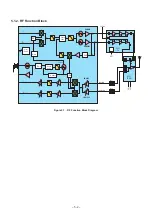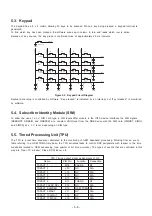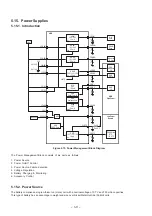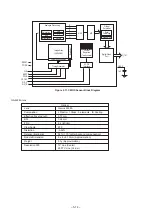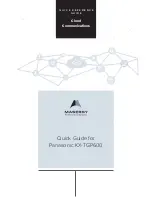
– 5-6 –
5.3. Keypad
5.4. Subscriber Identity Module (SIM)
The Keypad has a 5 x 4 matrix, allowing 20 keys to be scanned. When a key being pressed, a keypad interrupt is
generated.
To find which key has been pressed, the software scans each column in turn and reads which row is active.
Because of key bounce, the key press is confirmed twice at approximately 20 ms intervals.
Keyboard scanning is controlled by software. "Key pressed" is indicated by an interrupt, but "key released" is monitored
by software.
To allow the use of a 3 V SIM card type, a SIM level-shifter module in the IOTA device interfaces the SIM signals
(DBBSRST, DBBSIO, and DBBSCK) at a constant VRIO level from the DBB device with the SIM card (SIMRST, SIMIO,
and SIMCK) at a 3 V level, depending on SIM type.
5.5. Timed Processing Unit (TPU)
The TPU is a real time sequencer dedicated to the monitoring of GSM baseband processing. Working from an event
table referring to a GSM TDMA time base, the TPU activates tasks to control DSP peripherals with respect to the time
constraints related to GSM sequencing (one quarter of bit time accuracy). The types of events that are controlled in this
way are 'Open TX window', Close RX Window, etc.
Figure 5.5. Keypad Circuit Diagram
TSPACT 1
M14
PAENA
RF
TSPACT 2
L12
NC
N/A
TSPACT 3
L13
NC
N/A
TSPACT 4
J10
NC
N/A
TSPACT 5
K11
NC
N/A
TSPACT 6
K13
TRENA
RF
TSPACT7:CLKX_SPI
K12
NC
N/A
TSPACT 8:nMREQ
K14
GSM_TXEN RF
TSPACT 9:MAS1
J11
NC
N/A
TSPACT 10:nWAIT
J12
NC
N/A
TSPACT 11:MCLK
J13
NC
N/A
TPU Timing output signal assignments of G2
Name
PIN No.
Function
Connection
DGND
DGND
DGND
DGND
DGND
DGND
DGND
DGND
DGND
DGND
COL3
ROW4
ROW3
ROW2
ROW1
ROW0
S13
#
S20
UP
S11
2
S12
S1
Power / End
S15
6
S18
Left
S16
3
S3
*
S14
9
S5
4
S7
8
S19
Down
S9
0
S10
5
S8
Menu
S4
7
S17
Right
S21
Send
S6
1
C130 33p
C129 33p
C136 33p
C135 33p
C134 33p
C133 33p
C131 33p
C132 33p
C128 33p
S2
Soft-keyL
Soft-keyR
COL2
COL1
COL0
PWON
Содержание EB-X100
Страница 68: ... 8 19 ...
Страница 69: ... 8 20 ...











